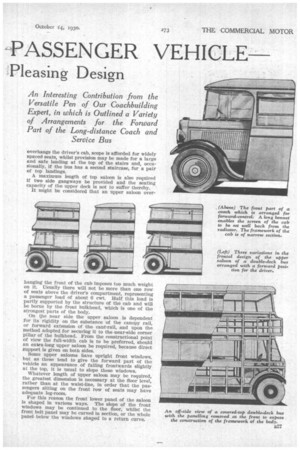The FRONT of the PASSENGER VEHICLE
Page 52

Page 53

If you've noticed an error in this article please click here to report it so we can fix it.
the Importance of Pleasing Design
THERE is much variation in the aspect of the front of the coach and motorbus, owing to (I) the passenger chassis being controlled either from behind or from the side of the engine, (2) the mounting of half and full-width cabs, and (3), with the double-decker, the different styles of upper saloon adopted.
The small and medium-sized bus or coach body is usually mounted on the conventional type of chassis. The degree of attractiveness of the vehicle, apart from the general design of the body, is in some measure dependent on the shape and proportions of the radiator shell and bonnet. Generally speaking, to look well the radiator casing should be about twice as high as it is wide. The appearance is often improved if the impression of height be increased by dividing the front of the radiator with a vertical bar.
A high radiator ensures a high bonnet, which is essential if the waistline or belt-rail of the body is to be at the same level. If a continuous horizontal line be pre-served from one end of the vehicle to the other its length is emphasized and its height apparently reduced.
The bonnet is frequently sharply tapered in plan, but the width at the dash is still much less than the overall width of the body, consequently the panelling immediately behind the dash is curved abruptly outwards. On top of the dash framework a sloping screen is often mounted, with a triangular window at each side. As the body is wider at the back of these windows than it is at the front of them, they are inclined towards one another, with the result that the sloping screen placed in front is wider at the roof than it is where it meets the top of the dash.
The sloping sides to the staggered screen May be regarded as a characteristic feature of the passenger vehicle which has the normal type of steering, and it gives a distinctive appearance to the front of it.
When an off-side cab is built beside the engine of a single-decker the best effect is obtained if the cab be made as unobtrusive as possible. It is an advantage if the bonnet be not only high but also comparatively long. Then the sloping screen May be set a few inches back from the radiator, giving an arrangement which tends to break up the mass of the combined bonnet and cab.
This may not be important with a service bus, but it is a point which may be studied with advantage if the cab forms part of a coach. This compartment also has a more elegant appearance if the rail which lies on ter of the bonnet be reduced to its smallest proportions and no intermediate pillar be framed-in between the screen and the back of the cab on the near side.
The front pillar of the body may also be staggered for its full length to match the inclination of the screen.
A new bonnet is often made for a private car in order that it shall harmonize better with the general design of the body. With a coach having forward control only a new side panel would be required if some novel arrangement of louvres were produced.
The front of the upper saloon of a covered-top double-decker may be level with the top of the cab screen, may project in front of it, or be recessed. When the upper saloon is of maximum length and it overhangs the driver's cab, scope is afforded for widely spaced seats, whilst provision may be made for a large and safe landing at the top of the stairs and, occasionally, if the bus has a second staircase, for a pair of top landings.
A maximum length of top saloon is also required If two side gangways be provided and the seating capacity of the upper deck is not to suffer thereby.
• It might be considered that an upper saloon over hanging the front of the cab imposes too much weight on it. Usually there will not be more than one row of seats above the driver's compartment, representing a passenger load of about 6 cwt. Half this load is partly supported by the structure of the cab and will be borne by the front bulkhead, which is one of the strongest parts of the body.
On the near side the upper saloon is dependent for its rigidity on the substance of the canopy rail, or forward extension of thecant-rail, and upon the method adopted for securing it to the .near-side corner pillar of the bulkhead. From the constructional point of view the full-width cab is to be preferred, should an extra-long upper saloon be required, because direct support is given on both sides.
Some upper saloons have upright front windows, but as these tend to give the forward part of the vehicle an appearance of falling frontwards slightly at the top, it is usual to slope these windows.
Whatever length of upper saloon may be required, the greatest dimension is necessary at the floor level, rather than at the waist-line, in order that the passengers sitting on the front row of seats may have adequate leg-room.
For this reason the front lower panel of the saloon is shaped in various ways. The slope of the front windows may be continued to the floor, whilst the front belt panel may be curved in section, or the whole panel below the windows shaped to a return curve.




















































































































